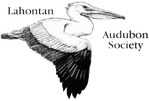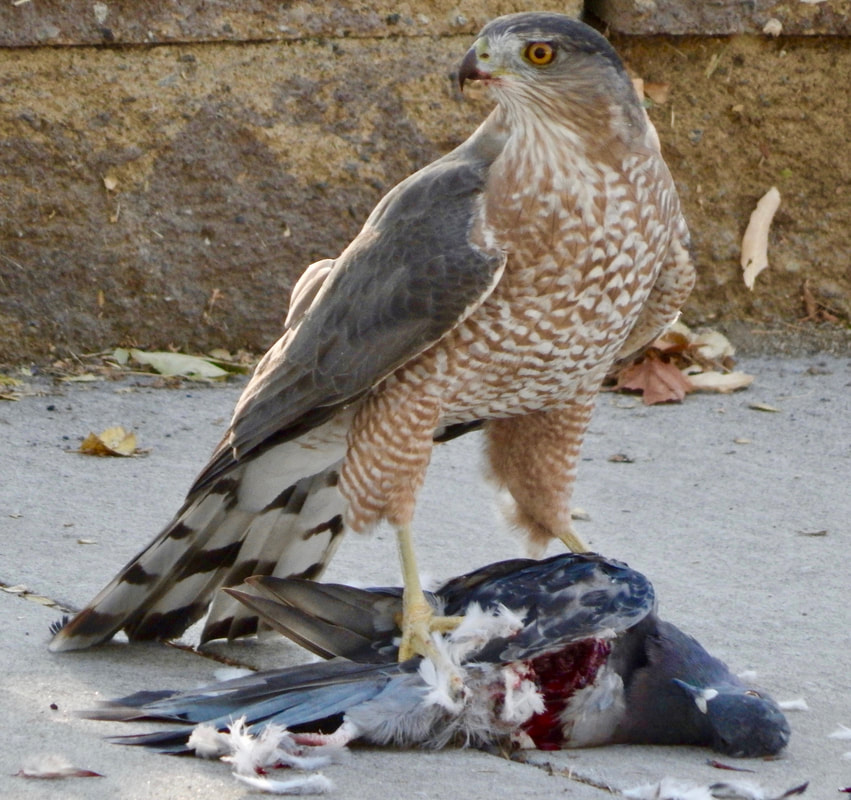|
By Alan de Queiroz In the spring of 2022, a pair of Cooper’s Hawks nested on our street in Reno. Almost every morning, I would hear them, mostly the typical Cooper’s “kak kak kak kak kak,” but other less familiar calls too. I watched them build the nest, an ungainly tangle of branches that often swayed so crazily in the wind that I half-expected it to fall right out of the tree (but, of course, it didn’t, and it’s still there, along with a second nest the pair built but never used). I saw the male bring prey to the female and then mate with her, either while she was still eating or right after, an immediate food-for-mating exchange that I’ve heard is peculiar to Cooper’s Hawks. Eventually, there were three young hawks in the nest, and, with the parents having to feed these nestlings and themselves, the carnage along our street was astonishing. It seemed that almost any time I was around the house, a hawk with a small bird or mammal in its talons would fly up to the nest or would alight on a perch and tear apart the prey. The sidewalk underneath a favorite feeding site was often littered with bits of flesh and clumps of feathers. I have to admit I was more fascinated than disgusted by these sights. One of the reasons I watch birds is to feel more connected to the natural world, and the constant sight of these hawks clutching their prey ratcheted up that feeling. Nature “red in tooth and claw” was flying over our yard every day, bringing a touch of wildness to the neighborhood. At the same time, though, the hawks were a reminder that, in this Age of Humans, it’s increasingly difficult to say what is natural, especially in cities. On the one hand, Cooper’s Hawks are native to northern Nevada, and, so, most birders think of them as a natural species in this place, unlike, say, the introduced European Starlings, Rock Pigeons, and House Sparrows. On the other hand, the lives of these urban hawks are obviously now bound up with ours. They live, after all, in a highly constructed landscape, and this is not just happenstance or inertia, not just the fact that Cooper’s Hawks were already here and managed to persist as the city rose around them. These hawks have apparently become common breeding birds in Reno only within the past few decades, probably drawn in by the high density of birds they can prey upon. The city is not just where they happen to be; it’s a magnet that pulls them in. The lives of our neighborhood Cooper’s Hawks were clearly tied to this human-altered environment. They built their nest in one of the many Siberian Elms lining the street, using branches from the elms and other non-native trees. Their favorite feeding perch was the top of a streetlight pole, a convenient flat surface high above the ground where they could easily stand and rip into their prey. Although I could rarely tell exactly what they were eating, they were almost certainly feeding on many non-native birds, such as Rock Pigeons and Eurasian Collared-Doves, and they were probably catching birds attracted to feeders. I saw the hawks encounter non-prey animals also, either as chaser or the one being chased, and these included three typical urban species—Mallards and American Crows, which are native birds that thrive in cities, and house cats. There hasn’t been much research on the Cooper’s Hawks in Reno, but studies in other cities have shown many influences of the urban environment on these birds, beyond the obvious things I saw in our neighborhood. For instance, researchers in Tucson found that the most common cause of death for Cooper’s Hawks is crashing into windows. And another study showed that female Cooper’s Hawks in Milwaukee are especially likely to cheat on their mates, a result the investigators believe is tied to the high density of these hawks within the city. In other words, in all sorts of ways—in what they eat, where they nest, how many partners they mate with, and how they die—the lives of urban Cooper’s Hawks have been altered by their human surroundings. These native raptors colonized Reno and other cities on their own, but, if natural means “unaffected by humankind,” their lives are extremely unnatural. Once you start thinking about birds in this way, it becomes clear that nearly all of the native birds in Reno are leading lives shaped by humans, often enormously so. This is obvious for some of them, such as the Brewer’s Blackbirds and California Gulls that hang out in parking lots looking for scraps, the large flocks of Canada Geese that gather to graze in city parks and golf courses, or the many birds that visit feeders every day. But it’s also true in more subtle cases. For instance, consider the Red Crossbills that show up in Reno during some winters. These unusual finches feed mostly on conifer seeds and are often seen prying open cones of one sort or another. When in town, they have quite a few conifers to choose from, both in terms of individual trees and different species. But, before people built a city here and planted trees, there were probably few if any conifers in the flatlands of the Truckee Meadows. And, with no conifers, there was little reason for Red Crossbills to visit the area; they might have stopped briefly to feed on buds or berries, but they probably wouldn’t have stuck around. So, when we see crossbills feeding on conifer seeds in the city, we are, as with the Cooper’s Hawks, seeing birds drawn to a human alteration of the environment. The list of such human influences on birds in Reno is very, very long. A small piece of that list includes: the road-killed animals eaten by American Crows, Black-billed Magpies, and other birds; the culverts and bridges used as nesting sites by Cliff Swallows; the ornamental trees that attract sapsuckers (they seem to especially like Old World cedars and Scotch Pines); and the non-native crayfish that wintering Hooded Mergansers catch in city ponds. In fact, I doubt if there are any bird species that live in or commonly visit Reno that are not strongly affected by such human influences. The urbanized lives of Cooper’s Hawks are part of the rule, not the exception. The Anthropocene, this Age of Humans, has been calamitous for birds, with our collective actions causing many extinctions, along with huge and ongoing population declines. In the Truckee Meadows, Western Meadowlarks, Horned Larks, and Lesser Scaup are all becoming harder to find, probably a reflection of overall declines in these species. Nature is being diminished here, as it is everywhere. And you could think of the altered lives of our city birds as part of that diminishment, a sort of unwilding of nature. Call it the “pigeonification” of the local bird fauna. Still, maybe there is at least one small thing, a consolation prize, to be taken from contemplating the unnatural lives of urban birds. That small thing is a connection to other species, not in spite of our influence on them, but because of it. We are not just observers of these city birds; we are an important part of their world. In fact, to a great degree, we are the creators of that world. Maybe it’s just delusional optimism, but I can imagine that recognizing our influence on these birds could give us a greater feeling of responsibility for them. We might feel—we should feel—that we need to be caretakers of what we have constructed. And that, in turn, could lead to decisions more often made with the birds in mind, whether in our own yards or for the city as a whole. |
topics
All
Archives
July 2024
|




 RSS Feed
RSS Feed